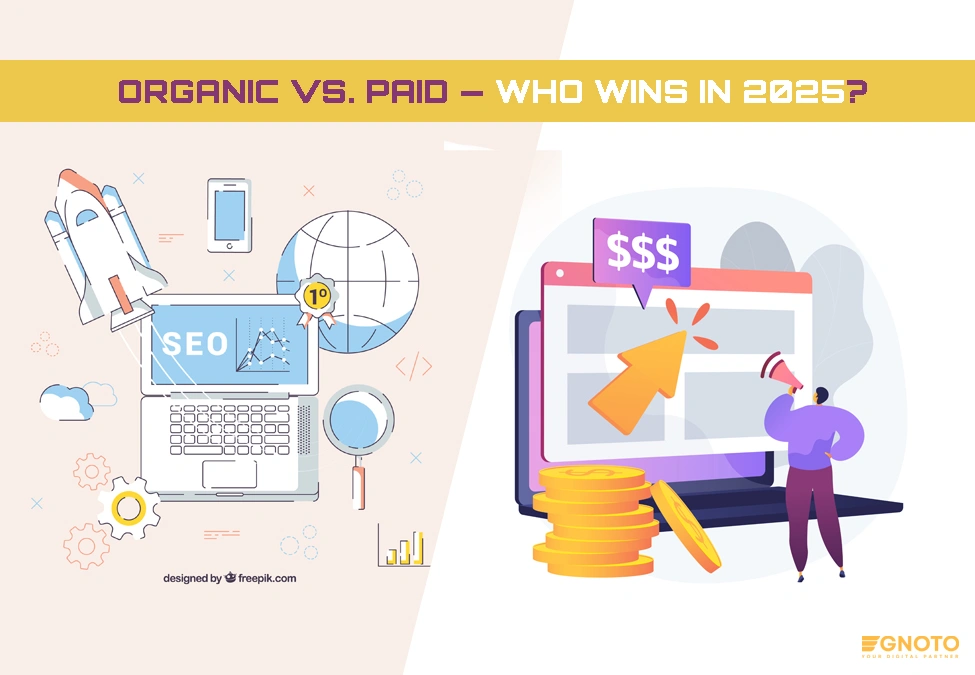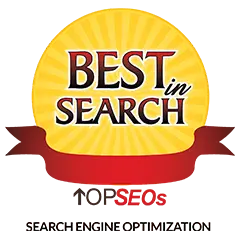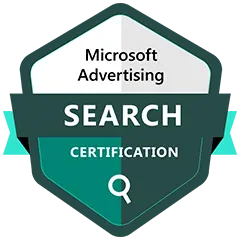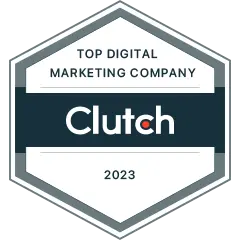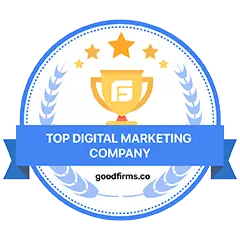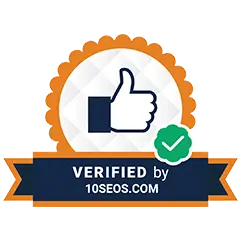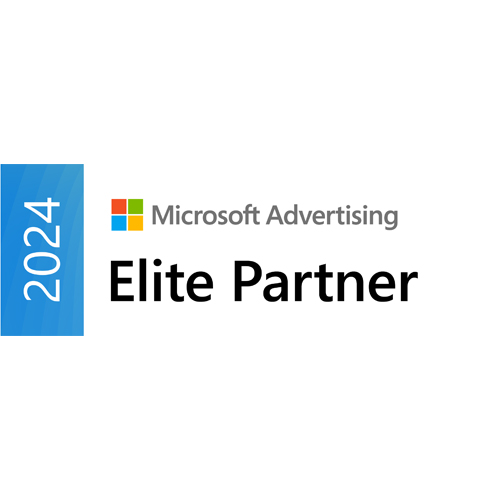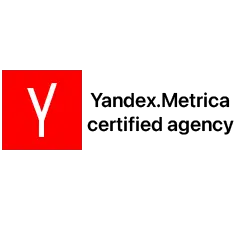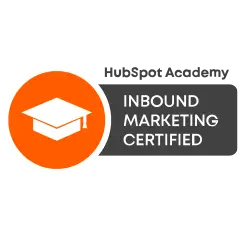Most businesses face this dilemma when they want to increase website traffic. Organic social media campaigns take time to show results, but they are less expensive. In contrast, paid ads are more expensive but are more likely to provide results in a short time. Both ways have their pros and cons. It creates confusion among businesses to find the most effective way, especially in today’s time when AI search engines are growing.
Whether you are ready to break new ground or have an established business, understanding what works best in 2025 and beyond will strengthen your online presence. It will also help you develop more effective digital marketing strategies as per current customer behavior and demand.
This decision is inevitable if you want to create a winning social media strategy in 2025.
We have compared both types of digital marketing, so keep reading to compare them. Go through the positives and negatives of both approaches and ensure your success in this new year.
What Is Organic Social Media Marketing?
Organic means done with no intention of selling something. It grows your brand slowly, and one day, people automatically buy from your brand without being asked. You don’t have to pay for the promotions in this type of marketing. For example, on LinkedIn, many founders write posts. They are not telling you to buy anything, but keep you engaged with the brand.
Organic social media marketing feels like you are engaging with a human, not a company. It humanizes your company. But for this, you have to post on a regular basis and maintain consistency. You post content, such as photos, videos, stories, and text, to engage with your audience.
People find your content through hashtags, shares, follows, or by visiting your profile. This method takes time, but it helps build trust and a real connection with your followers. Brands also use organic marketing to share behind-the-scenes content, answer customer questions, or build a community. It’s free, but, as we said a few lines above, it needs consistency and creativity to work well.
What Are Paid Ads or Paid Marketing?
On the other hand, paid marketing requires you to spend a good amount of money based on the type of PPC and advertising strategy. Paid ads are shown to your target audience, so they are not run on a chance, unlike organic marketing, where results are uncertain. You set a budget, choose your audience (like age, location, interests), and your ad shows up in their feeds or stories, even if they don’t follow you! It is also a form of forced marketing.
However, this method enables businesses to reach a wider audience more quickly. It especially helps when you want to launch a new product and run a sale. If you are looking for fast growth and can’t go slow with organic marketing, paid ads can work effectively.
Well, paid ads give results fast, but once you stop spending, the visibility usually drops.
In short:
- Organic = long-term trust and engagement.
- Paid = fast reach and conversions.
The most successful brands in 2025 are using a smart mix of both. But depends on several factors which type of marketing will suit the best. And, you can decide on it when you are aware of the pros and cons of both types of digital marketing methods.
The most successful brands in 2025 are using a smart mix of both. But depends on several factors which type of marketing will suit the best. And, you can decide on it when you are aware of the pros and cons of both types of digital marketing methods.
Organic Social Media Campaigns vs. Paid Ads
Both have pros and cons, and both serve their purpose. So, the decision can be difficult when you are not aware of your purpose, like what you want to achieve, expressions, visibility, clicks, sales, website traffic, or others. Here are some criteria to compare them clearly and easily.
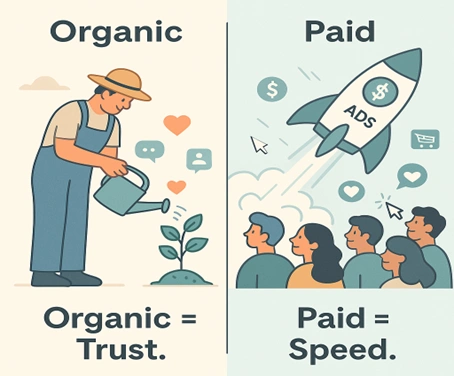
1. Reach & Visibility:
Organic social media marketing relies on shares, comments, and likes to go viral and appear in the feeds of as many people as possible. Well, it builds trust on one side, but on the other side, you have to be patient to witness the visible results. If you want fast results, it comes at a cost
Meta reports that organic reach on Facebook and Instagram hovers around 5-8% of followers. Paid ads, however, give immediate reach to a targeted market. Want fast visibility? Paid wins. Want long-term trust? Organic is key.
2. Cost & Return:
Organic is cost-effective. You need time and effort, not money, for a successful marketing campaign using this method. HubSpot reports that companies with organic marketing can save 30% in acquisition costs compared to ads.
While paid marketing requires a budget, in which you pay per click, impression, and conversion. Since you are paying for results, you expect the results must appear. And, it often creates a feeling of anxiety.
Example of organic marketing: A small bakery posted recipes on TikTok and used trending sounds. Within weeks, a 10% increase in local foot traffic cost zero ad spend.
3. Engagement & Loyalty
For this criterion, organic marketing is a clear winner because it builds trust, community, engagement, and makes potential customers feel attached to your brand story. Paid ads can also convert, but they are less likely to engage and build trust.
Example: A fitness brand used organic Reels to show real customer transformations. The comments turned into peer support. It boosted brand loyalty, something a simple ad can’t achieve.
4. Speed & Testing
You can easily measure the success of paid marketing campaigns through A/B testing, headlines, monitoring, and visuals. A simple tracking tool can explain what works and how, like how many days you achieved a particular target. Organic takes longer to figure out what’s working and what isn’t.
Nowadays, short‑form videos like TikTok, Reels, and Shorts dominate. Paid marketing works like a push for organic marketing to provide quicker results.
5. Sustainability & Long-Term Growth
When it comes to sustainability and long-term growth, organic marketing tends to perform better because it builds trust before attracting customers to buy. You can reshare older content and build assets over time. But paid ads stop delivering when you stop spending. For example, you create a blog on “How to manage your finances for more savings?” The content will remain online and continue to provide you with some sort of results.
You can even repurpose the content and create a podcast, multiple social posts, a YouTube video, and more from just a single well-written blog.
6. Audience Trust & Perception
How audience react to different marketing strategies? It’s crucial to understand not only how to choose the right marketing method but also to develop more effective strategies. And when it comes to trust, most businesses rely on organic methods because they feel authentic to their audiences. It is less polished and more genuine, which does not sound like someone is trying to sell you something. It feels like they are just trying to inform or educate you about something.
But, paid can feel “too polished” or salesy, especially to Gen Z and Millennials. Surprisingly, more than 55% of users trust recommendations from creators more than traditional ads.
7. Ideal Business Model Match
Now, let’s match the ideal business and analyze which type of marketing works best with each model.
| Business Type | Organic Focus | Paid Focus |
| 1. Startup | Build awareness slowly with UGC and content | Ad campaigns for new products or promotions |
| 2. Established B2C | Leverage storytelling on how the company started and grew | |
| 3. Niche B2B | LinkedIn posts to position yourself as an industry leader | Write more whitepapers for niche decision-makers |
| 4. eCommerce holiday theme | Social posts and influencer partnerships | Retargeting ads for cart abandonment |
8. Algorithm Trends in 2025
Which marketing method does the algorithm support more, organic or paid? It’s hard to tell, but with a little analysis, we can figure it out. According to visible results, algorithm trends in 2025 prioritize video and community-driven content. Hashtags and trending audio still boost reach organically. But AI and personalization make paid ads powerful. But only when matched with accurate targeting.
What Works the Best for Your Business?
It’s paid ads or it’s organic, or you want a combination of both, how to decide on it? The best ways are mentioned below.
1. Are You New or a Small Business?
Answer- If yes, the best pick could be a combination of organic plus a little paid. You can build trust and establish a brand identity organically through Reels, user-generated content (UGC), or TikTok. Run small paid campaigns to test offers. This is because people don’t buy from brands they don’t trust.
2. Are You an Established Business?
Answer- If yes, a hybrid strategy can work the best because you have a lot to talk about in the form of brand stories, customer reviews, and other achievements, organically. Launch new products or sales with paid ads.
3. Are You a B2B or a Niche Market Business?
Answer- If yes, choose organic for authority and paid for leads. Post regularly on LinkedIn and write blogs to help users know about your services and information related to your field. Use paid LinkedIn or Google Ads for targeting decision-makers. Well, trust matters more in B2B, but ads can bring the right eyes to your brand.
4. Are You in eCommerce or Retail?
Answer- If yes, use paid ads for conversion and organic marketing for retention. You can use retargeting ads for cart abandoners and promo campaigns. Create content related to product tips, lifestyle, and other topics related to your business for organic reach. Shoppers need a push to buy, but stories and trust help them come back.
Long Story Short
The best approach is not either/or, it’s a combination of both. But it highly depends on the business and its goals. You can lead with organic, post regularly, tell stories, and build relationships. This is what the present generation like in content marketing. But if you have a budget and want a fast result, supplement with paid marketing, boost your top-performing posts, and do not forget to leverage trends proactively. You can launch a product teaser organically and then, with a small budget, utilize PPC on various platforms.
So, use organic social media marketing when you are not in a hurry and want to build deep and long-lasting relationships with your audience. Go for paid marketing if you want fast results. Or combine strategies smartly to achieve both.
